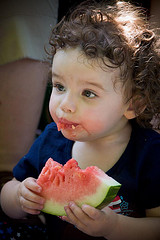 Childhood obesity has reached epidemic proportions but the good news is that it can be prevented. Sadly, the physical and emotional effects of childhood obesity are staggering. All the more reason why parents need to be informed about the few simple measures they can take to prevent their children from falling victim to it.
Childhood obesity has reached epidemic proportions but the good news is that it can be prevented. Sadly, the physical and emotional effects of childhood obesity are staggering. All the more reason why parents need to be informed about the few simple measures they can take to prevent their children from falling victim to it.
What Causes Childhood Obesity?
Weight gain occurs when more calories are consumed than are used by the body. The extra calories are stored as fat. Quite simply, when the number of calories consumed is about the same as the number of calories used, there is no weight gain. This, however, doesn’t explain why childhood obesity has increased over the past 30 plus years. In fact, the percentage of children from 6 to 11 years in the US who are obese has increased from 7% in 1980 to nearly 18% in 2012 and the percentage of obese teens aged 12 to 19 has increased from 5% to nearly 21% in the same years (www.cdc.gov/healthyyouth/obesity/facts.htm). Here are some reasons:
- A busy life style with both parents often employed has led to less cooking of meals at home and more eating out or ordering in fast foods.
- Many activities today in which children participate don’t require much movement such as watching TV, using the computer and playing video games. Moreover, for many children, these activities have replaced, to a large extent, more physical ones.
- There has been an increase in the consumption of processed foods with their high sugar content and fewer nutrients as well as of snack foods and sweet drinks and juices.
- Advertising of snack foods and drinks to children at younger and younger ages has had an effect on what they choose to eat.
- Children watch more TV today with many homes having a greater number of TV’s including those in children’s bedrooms.
- Take the TV out of the children’s bedrooms. “Having a TV in the bedroom is a strong predictor of pediatric obesity” (www.medicinenet.com/childhood_obesity/article.htm).
- Many children are sleeping less, probably as a result of using screen media This means they have less energy which they often make up for by eating more.
- The average portion of food has increased in size so that children are used to eating more.
- There has been the widespread proliferation of school vending machines, even in elementary schools, which sell sweet drinks, candy and other junk food.
Many of these causes are difficult for parents to control, especially as their children get older.
The Effects of Childhood Obesity
The effects of childhood obesity are grave. They can be divided into two categories: the physical and the emotional. Among the physical effects are high blood pressure, sleep apnea, type 2 diabetes, high cholesterol, hardening of the arteries and the start of heart disease, sleep problems, bone and joint problems, and non-alcoholic fatty liver disease which can lead to liver damage and scarring.
In addition to the physical, the emotional consequences can be equally devastating. They include depression which can lead to eating disorders or other self-destructive behavior, low self-esteem as a result of being teased, bullied and rejected, possible substance abuse, behavior and learning problems and social withdrawal. Add to this that “Twenty percent of obese 4-year-old children will grow up to be obese adults; 80% of obese teens will continue their obesity into adulthood” (www.medicinenet.com/childhood_obesity/article.htm) and we realize that often the problem is self-perpetuating. In other words, children don’t always grow out of it.
Simple Steps to Prevention
How can we prevent and reduce childhood obesity? According to the Mayo Clinic, “One of the best strategies to reduce childhood obesity is to improve diet and exercise habits of …[the] entire family (www.mayoclinic.org/diseases-conditions/childhood-obesity/basics/definition/CON-20027428?p=1). Here are some ways that parents should try:
- Limit sedentary activities such as TV, computer use and video games to a maximum of 2 hours a day.
- Have your kids get more exercise and when possible, use the car less and encourage them walk more.
- Make good food choices for meals such as including plenty of fruits and vegetables and not too many carbohydrates.
- Give your children treats only occasionally, perhaps once a week. It’s better not to eliminate them all or they might resent it and rebel.
- When your children have had enough to eat, don’t encourage them to eat more or to “clean their plates.”
- Use rewards other than food treats.
- Educate your children about good nutrition and try to make good food choices a family activity by involving everyone in planning healthy meals.
- Be relaxed about diet and eating. Too much intensity about it could lead to eating disorders.
- Don’t eat out too often, especially in fast food restaurants where the food is high in fats and calories and the portions are often very large.
- When possible, eat meals together as a family, trying to talk about everyone’s experiences during the day. Don’t keep the TV on since it has been found that this encourages people to eat more quickly forgetting how much they’re eating.
- Take the TV out of the children’s bedrooms.
- Be a good role model for your children in order to encourage them to have healthy eating habits.
As parents, it’s good for you to know that despite the current obesity epidemic, you have it within your control to protect the physical and emotional health of your children both today and in the future.
Do you have any ideas you’d like to add? If so, we’d appreciate hearing from you.
photo credit: <a href=”http://www.flickr.com/photos/troybthompson/3571914046/”>Troy B Thompson</a> via <a href=”http://photopin.com”>photopin</a> <a href=”http://creativecommons.org/licenses/by-nc-nd/2.0/”>cc</a>
